Make a Difference at Universities: Pioneering a Landscape for Women Leaders
On December 5, 2022, a dialogue was held at the University of Tokyo between President Yuko Takahashi of Tsuda University and President Teruo Fujii of the University of Tokyo as a project of the 30% Club Japan University Group. With the aim of discussing efforts on how to reach having 30% of top positions filled by women at universities, we invited President Yuko Takahashi of Tsuda University, who has written several books, including How Can the Number of Women University Presidents Be Increased?; President Teruo Fujii of the University of Tokyo, who made half of the board members women when he took office; and Haruko Nagayama, Chair of the Board of Deloitte Tohmatsu Group, to moderate a discussion on how universities can overcome unique challenges with a view to setting goals for the university group.
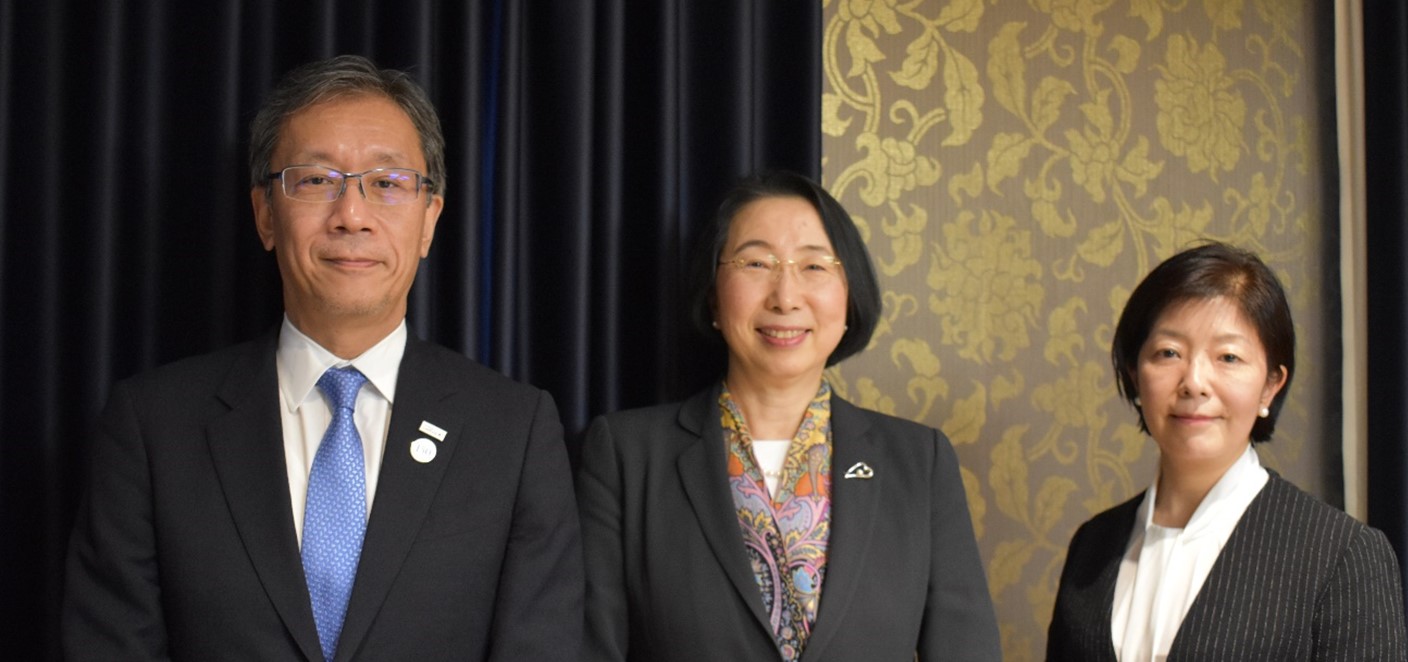

The Significance of Promoting Women’s Activities
Ms. Nagayama: I’m Haruko Nagayama, Vice Chair of 30% Club Japan and Chair of the Board of Deloitte Tohmatsu Group. The board chair is also a kind of role model who pushes to shape the culture of an organization, and I recognize that I was chosen as a representative of an organization that promotes diversity. First of all, I would like to ask you about the significance of promoting women’s activities at universities.
President Takahashi: University is the final chance for students to stretch themselves as far as possible before going out into the world. When we think about how students perceive themselves and what kind of landscape they see as they reconfigure this image, it is important to consider how many images of women there are on campus. Photos of past presidents are displayed in various university conference rooms, but no women are visible.
If the university is serious about creating a society in which women are active, it is essential to increase the number of women faculty members and the number of women in upper-level positions to close to 30%, and to send a message to the women enrolled that this place is a space that sincerely welcomes and empowers women. In Japan, including our university, such things have not been done adequately. In addition to increasing the percentage of women faculty members, it is also important for the University of Tokyo to produce a woman president.
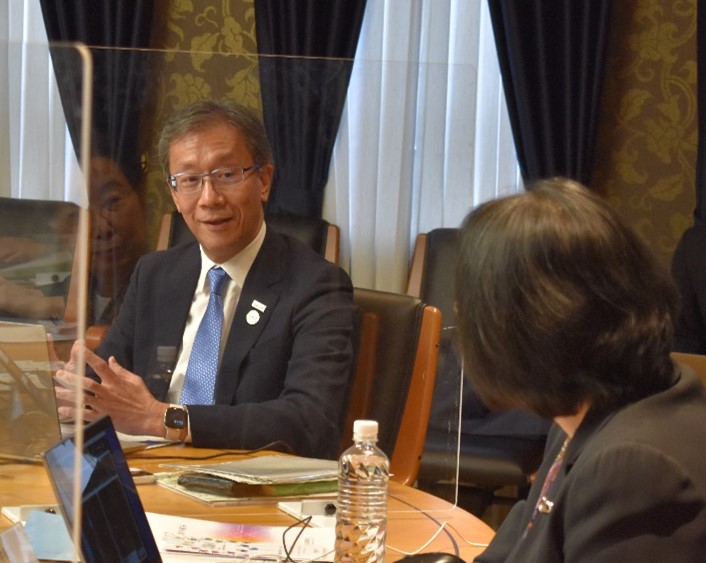
President Fujii: As such, at the beginning of the President’s term, we requested that five out of nine members of the Board of Directors be women. Since the university is a place where knowledge is cultivated through academics, there should be as many viewpoints as possible, and the place should be created while taking advantage of these diverse opinions. There was a time when all the speakers at plenary sessions (keynote speeches, etc.) at international conferences were men, and I thought, “This is not right.” Although there were women who had achieved excellent results, the representation of women was clearly low.
It is extremely important to discuss diverse perspectives to reach the heights of academic excellence. It is important to create a place where decisions can be made based on a variety of opinions, not just the opinions of certain people. The university’s new basic policy, “UTokyo Compass”, released last September, a set of principles, goals, and specific actions that will guide the university in the coming decades, under the title “Into a Sea of Diversity: Creating the Future through Dialogue”. At Todai, too, the statues are all of men. I think it is important to have women participate in higher positions to create a place everyone wants to come to.
President Takahashi: University is the final chance for students to stretch themselves as far as possible before going out into the world. When we think about how students perceive themselves and what kind of landscape they see as they reconfigure this image, it is important to consider how many images of women there are on campus. Photos of past presidents are displayed in various university conference rooms, but no women are visible.
If the university is serious about creating a society in which women are active, it is essential to increase the number of women faculty members and the number of women in upper-level positions to close to 30%, and to send a message to the women enrolled that this place is a space that sincerely welcomes and empowers women. In Japan, including our university, such things have not been done adequately. In addition to increasing the percentage of women faculty members, it is also important for the University of Tokyo to produce a woman president.

President Fujii: As such, at the beginning of the President’s term, we requested that five out of nine members of the Board of Directors be women. Since the university is a place where knowledge is cultivated through academics, there should be as many viewpoints as possible, and the place should be created while taking advantage of these diverse opinions. There was a time when all the speakers at plenary sessions (keynote speeches, etc.) at international conferences were men, and I thought, “This is not right.” Although there were women who had achieved excellent results, the representation of women was clearly low.
It is extremely important to discuss diverse perspectives to reach the heights of academic excellence. It is important to create a place where decisions can be made based on a variety of opinions, not just the opinions of certain people. The university’s new basic policy, “UTokyo Compass”, released last September, a set of principles, goals, and specific actions that will guide the university in the coming decades, under the title “Into a Sea of Diversity: Creating the Future through Dialogue”. At Todai, too, the statues are all of men. I think it is important to have women participate in higher positions to create a place everyone wants to come to.
Women Leaders Do Not Arise Spontaneously
President Takahashi: University presidents have also had very limited opportunities to be educated by women faculty members. As for myself, probably 60% or 70% of the credits I earned at Tsuda University were from courses taught by women. I believe that the experience of taking classes from these women, who had been going through various life events and who represented a diversity of generations, has led me to where I am today.
Ms. Nagayama: Were any measures put in place to convey the image of a predominantly women faculty at Tsuda University? Did it happen spontaneously?
President Takahashi: I believe it is the founding spirit. When Umeko Tsuda tried to create an institution of higher education for women, women were not only forbidden from enrolling at the Imperial University, they were also denied admission into the old high school system. Until the mid-twentieth century, women were in such a situation. The founding spirit of the University was to make the kind of higher education offered at the old high schools and imperial universities of the time accessible to women.
In addition, before returning to Japan to set up a school, Umeko Tsuda established a scholarship program where she had been studying abroad. She had in mind the training of women who would follow in her footsteps. In other words, women leaders do not arise spontaneously. A 122-year history of higher education institutions was woven because of the programs Umeko Tsuda created in the 19th century to develop women leaders. It is impossible to try to produce women leaders without any support. In this sense, I believe that President Fujii is an “ally” of women leaders. A panel composed entirely of men is called a “manel”. I think it is also extremely important to produce male allies like President Fujii, who has declared that 20-50% of the panelists must be women and promotes having women as the next representatives. Inazo Nitobe, who was involved in the establishment of Tokyo Woman’s Christian University, was also a male ally of Umeko Tsuda. I would like to see The University of Tokyo project the image that being a male ally of women is cool (i.e., showing how advanced men are).
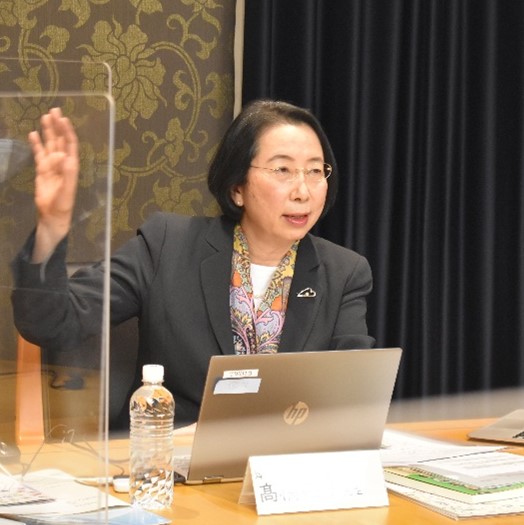
Ms. Nagayama: The University of Tokyo has a different “landscape” than Tsuda University, with a lower percentage of women in its pipeline of students. Other than that, are there any other factors that are shaping the “landscape” of the University of Tokyo?
President Fujii: As President Takahashi mentioned, I think the influence of people who can be seen as role models in becoming researchers is significant. There is still a situation where the percentage of women professors has not reached 10%. This needs to change. In this sense, I believe that increasing the number of women in higher positions is very important; it is a major point. As was recently reported, the goal is to increase the percentage of women faculty members by making approximately 300 of the 1,200 new professors and associate professors scheduled to be appointed over the next six years women.
Ms. Nagayama: Were any measures put in place to convey the image of a predominantly women faculty at Tsuda University? Did it happen spontaneously?
President Takahashi: I believe it is the founding spirit. When Umeko Tsuda tried to create an institution of higher education for women, women were not only forbidden from enrolling at the Imperial University, they were also denied admission into the old high school system. Until the mid-twentieth century, women were in such a situation. The founding spirit of the University was to make the kind of higher education offered at the old high schools and imperial universities of the time accessible to women.
In addition, before returning to Japan to set up a school, Umeko Tsuda established a scholarship program where she had been studying abroad. She had in mind the training of women who would follow in her footsteps. In other words, women leaders do not arise spontaneously. A 122-year history of higher education institutions was woven because of the programs Umeko Tsuda created in the 19th century to develop women leaders. It is impossible to try to produce women leaders without any support. In this sense, I believe that President Fujii is an “ally” of women leaders. A panel composed entirely of men is called a “manel”. I think it is also extremely important to produce male allies like President Fujii, who has declared that 20-50% of the panelists must be women and promotes having women as the next representatives. Inazo Nitobe, who was involved in the establishment of Tokyo Woman’s Christian University, was also a male ally of Umeko Tsuda. I would like to see The University of Tokyo project the image that being a male ally of women is cool (i.e., showing how advanced men are).

Ms. Nagayama: The University of Tokyo has a different “landscape” than Tsuda University, with a lower percentage of women in its pipeline of students. Other than that, are there any other factors that are shaping the “landscape” of the University of Tokyo?
President Fujii: As President Takahashi mentioned, I think the influence of people who can be seen as role models in becoming researchers is significant. There is still a situation where the percentage of women professors has not reached 10%. This needs to change. In this sense, I believe that increasing the number of women in higher positions is very important; it is a major point. As was recently reported, the goal is to increase the percentage of women faculty members by making approximately 300 of the 1,200 new professors and associate professors scheduled to be appointed over the next six years women.
Ban Men-only “Manels”
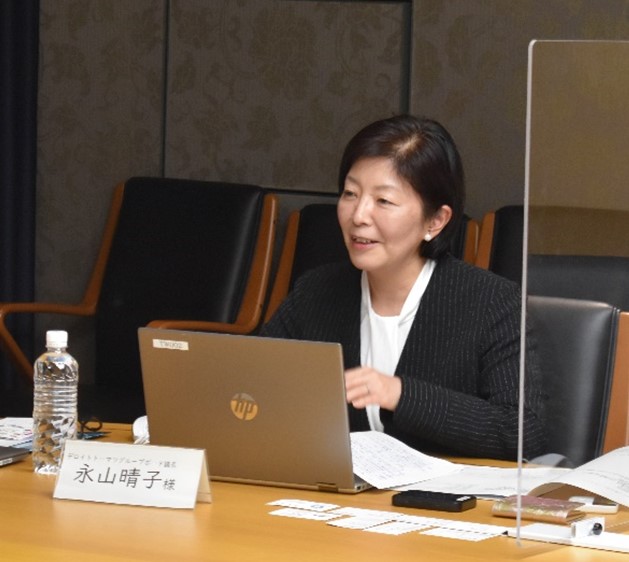
Ms. Nagayama: Has increasing the number of women on the board had an impact? President Fujii: The structure has changed, including that of the presidency, so of course there have been major changes. I also wanted to make the meetings among the board members a forum for lively discussion. It’s not about whether the previous situation was better or worse, but there was a change. Some of the board members have also been in management in outside companies or have worked extensively for international organizations. In this sense, different perspectives are added to the discussion, even from those who have been at the university for a long time.
Executive VP Hayashi (The University of Tokyo,Executive Vice President / Vice President): Manels were practically banned among the board members. I feel that the point that “there are no female panelists” has been properly raised at recent meetings.
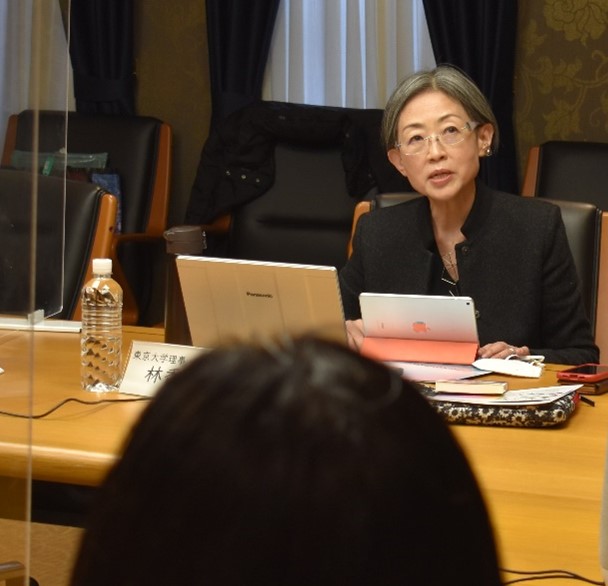
President Fujii: When we hold events in various faculties, men tend to step up, so we ask the relevant professors to make the panels in a form that includes women.
Ms. Nagayama: We also have a “panel promise,” promoting a rule that 40% of panelists must be male, 40% female, and 20% diversity adjusted. So far, we have only promoted the unit leaders. When that happens, it is not a 4-4-2. Through changing the cut-off point, for example, by bringing in women from a slightly younger demographic, the panel has gained a reputation for producing content more easily understood by the listeners. The “manel ban” works for any organization.
President Takahashi: Whenever a university president has been the main speaker, or whenever they have gathered, at so-called Presidents’ Conferences and such, there have been many manels. Even when the theme is “diversity and inclusion.” I always summon up the courage to speak up and say, “If you are going to have a panel on a topic like this, please include women and foreign nationals,” and I would like to encourage the male presidents to join us.
Ms. Nagayama: Is it correct to say that we have agreement on the idea of “no manels” here?
President Takahashi: I urge all universities that have joined the 30% Club to spread this message as well. From the world’s perspective, the current situation in Japan is so anachronistic that if one were to look at such a landscape, one would ask, “How long is Japan going to keep doing this?” President Fujii: I think you are right. I will endeavor to say something to that effect.
Increasing the Image of Women within the University of Tokyo
Ms. Nagayama: Regarding the hiring of women faculty members as announced by the University of Tokyo, it may be possible that “there is no one in the market” (no one who can be hired). What are your estimates on this?
President Fujii: We were prepared for many hardships to occur, but we have a renewed awareness that it is something that will not change unless we do it consciously. As for hiring, we won’t know until we try, but I think it is important that we decide on this and do it. It makes sense that there are many talented people out there, so I think it is important to create an environment that will attract such individuals.
President Takahashi: An environment and infrastructure that welcomes women is also important. At Tsuda University, there are many symbols of women and buildings named after women, but where can we find such images at the University of Tokyo? Also, Tsuda University has awards named after women, such as the “Ryoko Akamatsu Award.” How about the University of Tokyo?
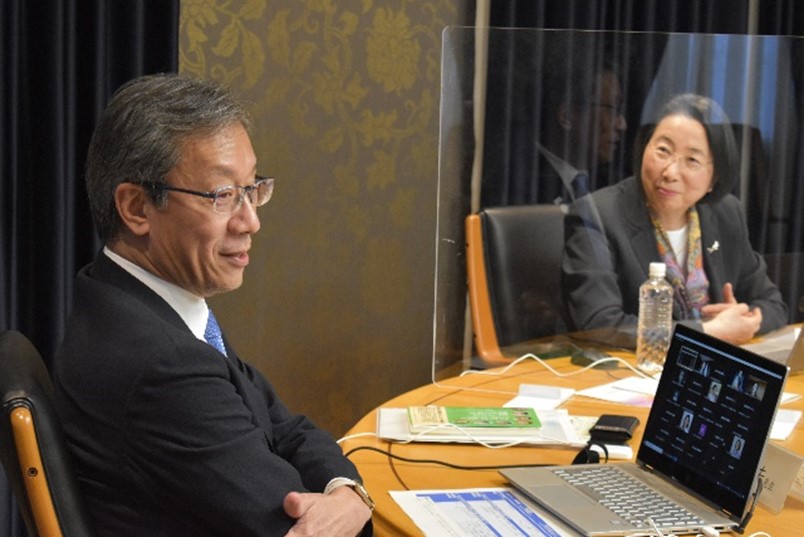
Executive VP Hayashi: As for the few images of women at Todai, I can think of one who looks like a nurse depicted in a relief on the wall of the hospital attached to the School of Medicine (“Diagnosis, Treatment, and Prevention in Medicine” by Takezo Shinkai) and an elegant woman in a classical Greek-like costume in a mural above the stage in the Yasuda Auditorium (“Spring Water” and “Harvest Fruits” by Miaki Kosugi). However, there is no prize bearing a woman’s name, is there? There is a prize bearing a man's name (the Shigeru Nanbara Award).
President Takahashi: Through awards we can show that women can accomplish anything. Isn't it important to set up the infrastructure to create an environment that welcomes, empowers, and includes women? The award is just one example, but it is important to make inroads to honor women in such a way.
Women came late to institutions of higher education. While Tohoku Imperial University started accepting women students in 1913, Tokyo Imperial University did not do so until 1946. Shouldn’t we examine the history of the University of Tokyo to date by asking the question why it lagged behind Tohoku University for 33 years?
At Tsuda University, we tell students about how women overcame difficulties to get to where they are today. Historically, how have Tsuda graduates been involved in overcoming various hurdles? For example, we are actively communicating the fact that Tsuda University alumnus Ryoko Akamatsu and former president Taki Fujita were involved in the passage of the Equal Employment Opportunity Law.
An environment where women are placed in the center and told their stories is something that is hard to find later in life, and I believe this is possible only at a women’s college. President Fujii, I don’t think you can talk only about women, but I think it would be empowering if you could create an opportunity to talk to women by placing women students at the center. Developing the infrastructure needed to create a comfortable environment for women, examining of how universities that are members of the 30% Club treat women in their university histories – there are many things that need to be reviewed.
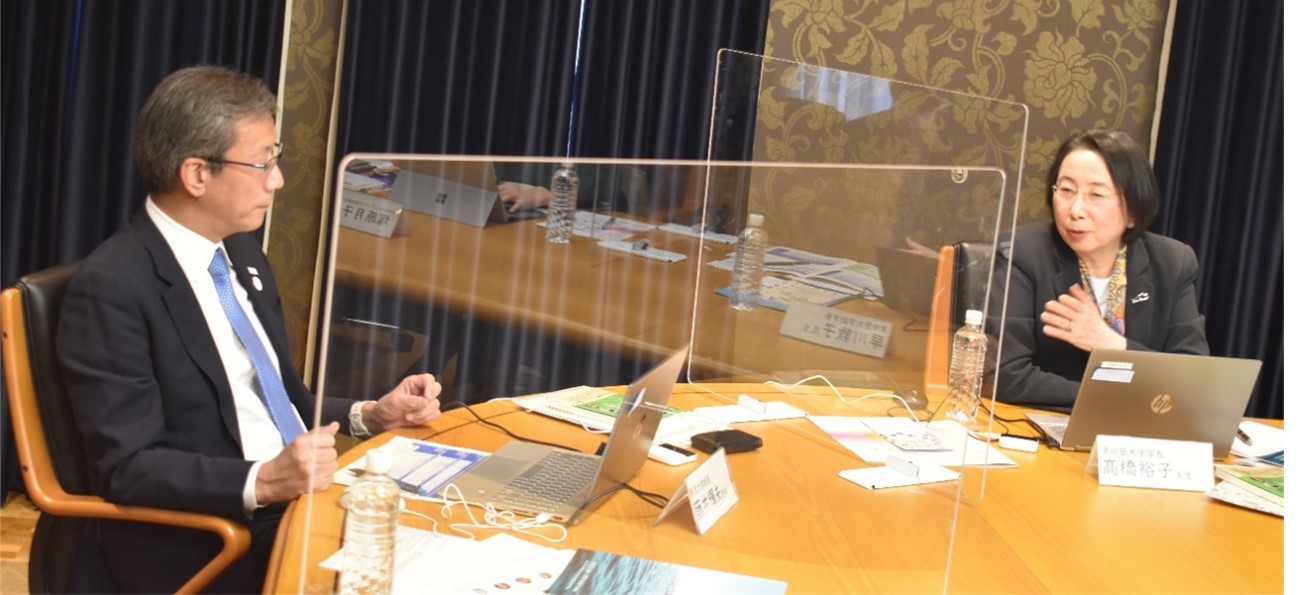
President Fujii: We were prepared for many hardships to occur, but we have a renewed awareness that it is something that will not change unless we do it consciously. As for hiring, we won’t know until we try, but I think it is important that we decide on this and do it. It makes sense that there are many talented people out there, so I think it is important to create an environment that will attract such individuals.
President Takahashi: An environment and infrastructure that welcomes women is also important. At Tsuda University, there are many symbols of women and buildings named after women, but where can we find such images at the University of Tokyo? Also, Tsuda University has awards named after women, such as the “Ryoko Akamatsu Award.” How about the University of Tokyo?

Executive VP Hayashi: As for the few images of women at Todai, I can think of one who looks like a nurse depicted in a relief on the wall of the hospital attached to the School of Medicine (“Diagnosis, Treatment, and Prevention in Medicine” by Takezo Shinkai) and an elegant woman in a classical Greek-like costume in a mural above the stage in the Yasuda Auditorium (“Spring Water” and “Harvest Fruits” by Miaki Kosugi). However, there is no prize bearing a woman’s name, is there? There is a prize bearing a man's name (the Shigeru Nanbara Award).
President Takahashi: Through awards we can show that women can accomplish anything. Isn't it important to set up the infrastructure to create an environment that welcomes, empowers, and includes women? The award is just one example, but it is important to make inroads to honor women in such a way.
Women came late to institutions of higher education. While Tohoku Imperial University started accepting women students in 1913, Tokyo Imperial University did not do so until 1946. Shouldn’t we examine the history of the University of Tokyo to date by asking the question why it lagged behind Tohoku University for 33 years?
At Tsuda University, we tell students about how women overcame difficulties to get to where they are today. Historically, how have Tsuda graduates been involved in overcoming various hurdles? For example, we are actively communicating the fact that Tsuda University alumnus Ryoko Akamatsu and former president Taki Fujita were involved in the passage of the Equal Employment Opportunity Law.
An environment where women are placed in the center and told their stories is something that is hard to find later in life, and I believe this is possible only at a women’s college. President Fujii, I don’t think you can talk only about women, but I think it would be empowering if you could create an opportunity to talk to women by placing women students at the center. Developing the infrastructure needed to create a comfortable environment for women, examining of how universities that are members of the 30% Club treat women in their university histories – there are many things that need to be reviewed.

This dialogue was observed by approximately 30 people, including the presidents of the 30% Club Japan university groups* and other 30% Club Japan members, and was followed by a question-and-answer session. We closed the meeting by confirming that, based on the learnings from the dialogue, we will report on progress at each university at the next plenary meeting of the university group, scheduled to be held in 2023.
*Participating universities in the University Group (in alphabetical order): Doshisha University, Keio University, Niigata University, Ochanomizu University, Osaka University, Showa Women’s University, Sophia University, Tsuda University, University of Tokyo (Chair)
The web-site of the 30% Club Japan is here.
*Participating universities in the University Group (in alphabetical order): Doshisha University, Keio University, Niigata University, Ochanomizu University, Osaka University, Showa Women’s University, Sophia University, Tsuda University, University of Tokyo (Chair)
The web-site of the 30% Club Japan is here.





